Medical expert of the article
New publications
Preparations
Expectorant herbs for bronchitis
Last reviewed: 04.07.2025

All iLive content is medically reviewed or fact checked to ensure as much factual accuracy as possible.
We have strict sourcing guidelines and only link to reputable media sites, academic research institutions and, whenever possible, medically peer reviewed studies. Note that the numbers in parentheses ([1], [2], etc.) are clickable links to these studies.
If you feel that any of our content is inaccurate, out-of-date, or otherwise questionable, please select it and press Ctrl + Enter.
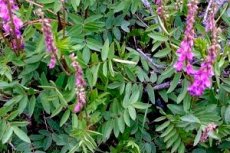
In acute viral bronchitis, herbs with both an immunostimulating effect and expectorant and mucolytic properties can be used. Viral pathologies often occur with fever, so antipyretic herbs can also be useful, especially for treating children. In this case, herbal treatment of bronchitis provides all the necessary therapeutic effects: it facilitates the process of cleansing the bronchi, reduces high fever, strengthens the body and promotes rapid recovery.
Naked licorice (liquorice)
This plant with a sweetish taste of roots is known as an excellent antiulcer remedy. But it is no less effective in the treatment of cough, showing a good expectorant and anti-inflammatory effect.
Method of administration and dosage. In the treatment of bronchitis with dry and difficult wet cough, pleurisy, pneumonia, mainly compositions based on licorice root are used.
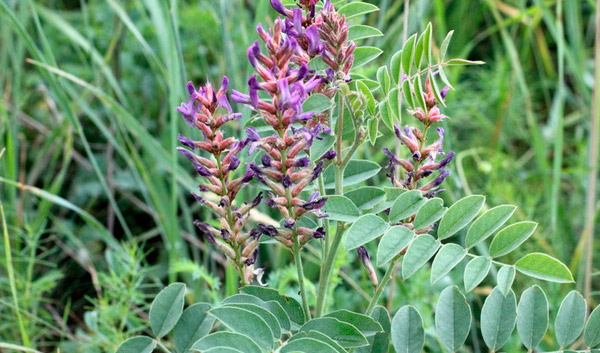
Composition for treating dry cough: Take 10 g of dry plant roots per glass of boiling water, place the composition in a water bath for a quarter of an hour, then remove from heat and leave to infuse for another hour. Bring the strained and squeezed composition to 200 ml with cool boiled water and drink warm in 3-4 doses.
As an anti-inflammatory and anti-allergic remedy for bronchitis and asthma, take a decoction of licorice root. Take 1 tbsp of roots per glass of boiling water. Boil the mixture for about 10 minutes and leave for another hour. Take strained up to four times a day, 1 tbsp.
For the treatment of children, you can use both a decoction and an infusion of licorice root. A single dose of medicine for children is one teaspoon or dessert spoon. Small children are given the medicine once a day. Teenagers and adult patients can simply chew a fresh root of the plant to treat colds with a cough.
Children love sweet medicines, so you can add a little honey to the decoction or infusion if the baby is not allergic to bee products. It is even better to buy licorice syrup at the pharmacy and give it to the child for a cough. Do not forget that pharmacy syrup contains alcohol, so you cannot give it to children with spoons. Children under 3 years old can be given no more than 2-3 drops of licorice syrup, diluting it in a spoon of warm water. Children under 12 years old are given 1/2-1 teaspoon of syrup, diluting it in 50 ml of water. Teenagers over 12 years old and adults are prescribed 1-2 teaspoons in 100 ml of water.
If you can't buy syrup at a pharmacy, but you can buy dry root extract, you can make your own sweet medicine by adding 20 g of alcohol and 160 g of pre-prepared sugar syrup to 8 g of extract. Mix all the ingredients well and store in the refrigerator. Homemade syrup has the same properties as pharmacy syrup, and you should take it in the same dosages.
Contraindications for use. Folk remedies and pharmaceutical preparations based on licorice root should not be taken by people with hypersensitivity to the plant, severe kidney disease or liver cirrhosis, arterial hypertension and heart failure, high obesity and potassium deficiency in the body (hypokalemia).
Children can be given licorice in syrup form from 12 months. However, licorice is strictly prohibited during pregnancy, as it increases estrogen levels and can disrupt hormonal balance, which can cause termination of pregnancy. It is not advisable to breastfeed a child during licorice treatment.
Diabetics are better off choosing recipes that do not contain sugar, i.e. infusions and decoctions.
Side effects. Taking licorice root formulations may be accompanied by increased blood pressure, mild allergic reactions in the form of rash and itching on the skin, edema syndrome and water-salt imbalance. High doses of licorice may negatively affect the sexual function of men and women.
Interaction with other drugs. When treating with licorice, you need to be very careful in choosing other drugs. For example, it is not recommended to combine licorice with diuretics, antiarrhythmic drugs (Verapamil, Cordarone, Sotalol), the cardiac glycoside Digoxin, as well as antacids and drugs that reduce stomach acidity, due to their ability to reduce the absorption of oral drugs.
In licorice we use only roots. They need to be dug either in early spring or late autumn. Dry in the sun, under a canopy or in a dryer with a temperature of no more than 60 degrees. Store licorice root in a dry room, it is better to place them in a glass container. Soy raw materials retain their properties for a long time - up to 10 years.
Plantain
This is not just an expectorant, but an emergency aid for coughs with difficulty in removing sputum. It has a bronchodilator effect, i.e. it is both a mucolytic (liquefies sputum) and an expectorant (promotes the removal of mucus from the bronchi by expanding their lumen and activating the work of the epithelium). In addition, plantain has a calming, anti-inflammatory, analgesic and antimicrobial effect.
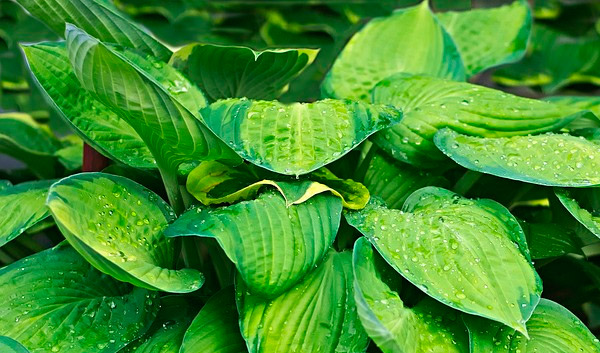
Method of application and dosage. For the treatment of bronchitis, accompanied by dry or unproductive exhausting wet cough, various parts of the plant are used.
If inflammation in the bronchi occurs in the autumn-summer period, while it is still possible to use fresh plantain leaves, a medicinal syrup is prepared from them. ½ cup of crushed leaves is mixed with the same amount of honey and kept on a warm surface (on the stove, on a bag of warm salt or in warm water) for 4 hours, covering the container with the composition with a lid. The finished syrup should be taken 3-5 times a day before meals. Single dose - 1 tsp.
Or another way to prepare syrup. Fresh leaves and petioles are used to prepare medicinal syrup. The raw materials are crushed and filled into a sterile jar. Sugar is added between the layers of the herb and stored closed in the cold for 2 months. After the specified time, the medicine is put in the refrigerator and used for cough 3 times a day before meals. Single dose - 1 teaspoon. It is recommended to hold the syrup in your mouth for a while, rather than swallow it right away.
Dry raw materials, including seeds and roots, can also be used to make syrup, but again, honey-based. 1 tbsp. of dry grass is poured with a glass of boiling water and kept in a water bath for 20 minutes, after which 1 tbsp. of honey is added to the composition and stirred until the honey dissolves. This syrup should also be taken before meals (preferably 30 minutes before a meal) 1 tsp. The frequency of administration is 3-4 times a day.
And here's another delicious expectorant recipe: grind dry plantain leaves into powder, add ¼ cup of sugar to ½ cup of powder, mix everything thoroughly and let it sit. The medicine should be taken before meals several times during the day. Single dose - 1 tbsp.
Contraindications for use. Syrups with plantain are not recommended for people with increased secretion of gastric juice, exacerbations of ulcerative diseases of the gastrointestinal tract, high blood viscosity and a high probability of blood clots, individual intolerance to the plant.
Side effects. Usually, the use of plantain does not cause unpleasant symptoms. Very rare complaints of diarrhea, vomiting, abdominal discomfort, allergic reactions leading to breathing difficulties due to swelling of the throat.
Interactions with other drugs. Plantain is one of the medicinal plants that is not recommended to be taken orally simultaneously with the cardiac glycoside "Digoxin", used to treat cardiac ischemia and heart failure.
Any parts of the plant used to prepare herbal medicines for bronchitis are harvested during the plantain flowering period (May-August). The seeds are collected after the plant has finished flowering. Only green, undamaged above-ground parts of the plant are suitable for use; those that have changed color to reddish or brown during life are not suitable.
Plantain raw materials can be stored in glass jars with lids, linen bags, paper bags in a dry place with good ventilation and no pests for 3 years.
Angelica sylvestris, also known as medicinal angelica
We use only the roots of the plant as medicine.
We dig up the annual plant after flowering in late autumn, when the leaves have already turned yellow and withered.
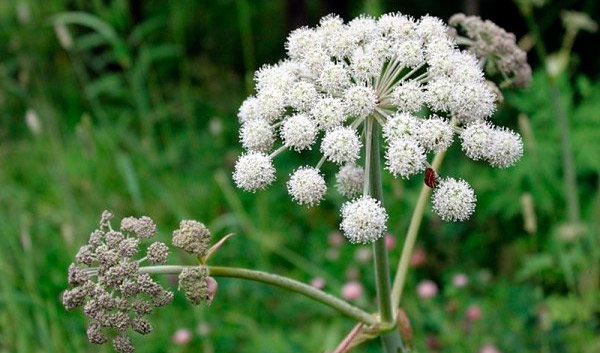
The roots of biennial plants should be harvested in the spring by digging them up together with the rhizomes, washing them with cold water and, if necessary, cutting them into thin strips in the rhizome area.
This plant has many names. It is also called angelica, hogweed, veznuk, lichen, pipe, stuffy grass, cowberry, etc. The plant has a pronounced expectorant, anti-inflammatory, antibacterial effect, which makes it popular in the treatment of bronchitis of both viral and bacterial etiology. It is also believed that angelica helps to reduce elevated temperature and reduces pain.
Method of application and dosage. The roots of the plant are most often used as medicinal raw material for bronchitis.
Root decoction: 3 tablespoons of crushed raw material are poured with a glass of boiling water and kept in a water bath for 30 minutes, covered with a lid. The strained decoction is topped up with water to 250 ml and the composition is drunk in 2 doses. The decoction should be drunk hot after meals.
Alcohol tincture: take half a liter of alcohol or vodka for 200 g of dry roots, insist the composition in a sunny place. After half a month, filter the tincture. For bronchitis, it is recommended to take the medicine 3 times a day, dripping into water. Single dose - 20 drops.
Infusion of various parts of the plant (root, leaves, seeds): 2 tablespoons of dry raw material are poured with 2 cups of boiling water and infused for six hours. Take strained ½ cup 3 times a day.
Angelica essential oil (2 drops) mixed with olive oil (1 tbsp) is used to rub the chest for difficult coughing.
Contraindications for use. Recipes based on angelica are not suitable for patients suffering from diabetes and ulcerative lesions of the gastrointestinal tract. It is not recommended to use them during pregnancy (there is a risk of premature birth), with uterine and other bleeding, decreased blood clotting, vascular weakness, tachycardia and, of course, hypersensitivity to the plant.
Side effects. Unpleasant symptoms such as vomiting, migraines, diarrhea, fainting or paralysis may occur due to an overdose of the drug. People with hypersensitivity may experience allergic reactions. During treatment with angelica, you should be careful with sunbathing, because the plant can cause photosensitivity.
The roots are dried either in a dryer at a temperature of no more than 40 degrees, or in a draft. The finished raw material is stored for no more than 2 years.
Horsetail
A rather attractive looking plant, reminiscent of a fir tree with cones at the end of its branches, which can be found along river banks, in fields, in thickets of bushes, in the mountains. But again, few people know that this plant can be used in hot dishes and baked goods, as feed for livestock, and also for medicinal purposes in acute and chronic bronchitis, bronchial asthma and many other diseases. And all thanks to the beneficial effects of the plant, among which are: anti-inflammatory, expectorant, antimicrobial, antispasmodic, astringent (reduces irritation of the inner walls of the bronchi).
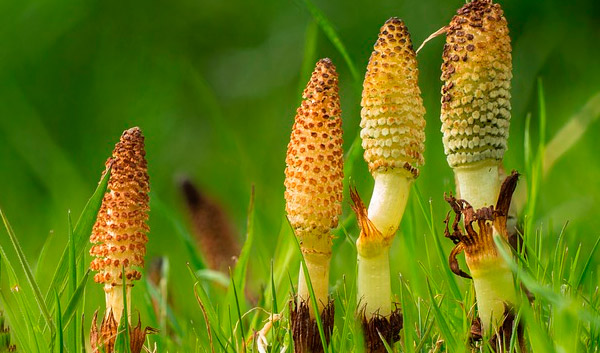
Method of application and dosage. A decoction of horsetail is considered an effective antitussive. Add 1 tbsp of the herb to a glass of boiling water, cover and keep in a water bath for 40 minutes. The strained decoction will decrease in volume, so it will need to be topped up with boiled water to a full glass. The resulting medicine is drunk three times a day, half an hour before meals.
To treat a cough, the decoction can also be prepared with milk, which will only enhance the effect. In this case, replace the glass of water with the same amount of milk, boil the mixture for about 20 minutes, strain and bring to a boil again. The daily dose is 1-2 glasses of the drink.
In the acute period, you can take a mixture of horsetail and fig juices. Single dose - 1 tbsp. The medicine should be taken at intervals of 2 hours.
Contraindications for use. Decoctions and infusions based on horsetail are not suitable for treating patients with nephritis, internal bleeding or a high probability of them, for example, with a stomach ulcer, hypersensitivity to the herb, during breastfeeding. During pregnancy, it can increase the motor activity of the uterine muscles, so without consulting a doctor, treatment with compositions containing horsetail is unacceptable. Children can be given ivy medicine after reaching 3 years of age.
You should not take horsetail herb for a long time, because it promotes the removal of potassium from the body and the destruction of vitamin B1. The course of treatment should not exceed 3 months.
Side effects of ivy are mainly limited to allergic reactions, nausea and vomiting, which usually occur with prolonged use.
The plant has fleshy leaves that require a special approach to harvesting and drying. Cut stems with leaves no longer than 0.3 m should be completely dry, without dew drops. They should be laid out on a surface or hung in a well-ventilated room. If the plant is laid out on paper or fabric, it should be turned over frequently to avoid rotting and spoilage of the raw materials.
The stems with leaves should be stored in cloth bags or paper bags in a dry place away from light for no more than 3 years.
Thermopsis lanceolata
This is a herbaceous plant with lovely small bright yellow flowers and not at all pleasant aroma. However, the latter does not detract from its properties for the treatment of bronchitis, pneumonia, colds, viral pathologies, as well as their symptoms. Even doctors agree with the benefits of thermopsis in the treatment of cough (and all thanks to the powerful expectorant effect), therefore, several types of pharmaceutical preparations have been created based on this plant.
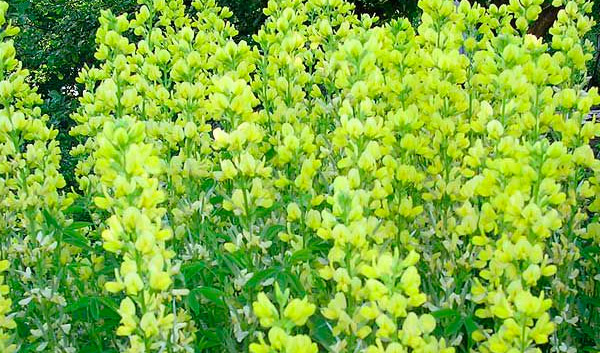
Method of administration and dosage. To treat chronic bronchitis, you can try using Thermopsis infusion. For 1 cup of boiling water, take 1 teaspoon (0.6 g) of dry raw material. The medicine should be infused for at least 8 hours. Single dose - 1 tablespoon. Frequency of administration for children - 3 times a day, for adults - 4-5 times a day.
For children under 6 years of age, the infusion is prepared at a rate of 0.2 g of dry herb per 200 ml of water. Up to 2 years, a single dose is ½ tsp. (2.5 ml), up to 6 years - 1 tsp. (5 ml). The frequency of taking the infusion is 2-3 times a day.
Here is a recipe for an infusion that stimulates the contraction of the bronchi, thanks to which an excellent expectorant effect is achieved. Take 1 g of thermopsis herb per glass of water, strain it after an hour and take 1 tbsp. 3-4 times a day.
Contraindications for use. Recipes with thermopsis are not recommended for people with hypersensitivity to the herb, as well as for those with ulcerative diseases of the gastrointestinal tract in the acute stage.
The herb is also not suitable for pregnant women who are not yet due to give birth, since thermopsis is sometimes even used to stimulate labor.
Side effects of Thermopsis may manifest as allergic reactions and vomiting. The latter is possible with an overdose of the infusion.
The plant is harvested between the beginning of flowering and the appearance of the first fruits (the fruits are not used to prepare the medicine). The grass should be cut with a knife, retreating from the soil 4-5 cm.
The grass can be dried both in the sun and in the shade. Temperatures up to 60 degrees are allowed in the dryer.
Thermopsis is a rather poisonous herb, so it is better to collect and process it with gloves, and wash your hands thoroughly after work. The raw material should be stored tightly packed for no more than 2 years.
Common goutweed (angelica, edible grass)
A perennial plant, the lifespan of which is equal to that of a human. It is an excellent honey plant, and feed for livestock, and a fragrant addition to dishes on our table, and a cure for many diseases. For bronchitis, goutweed is valued as an excellent antiseptic, anti-inflammatory and expectorant, included in the composition of chest collections.
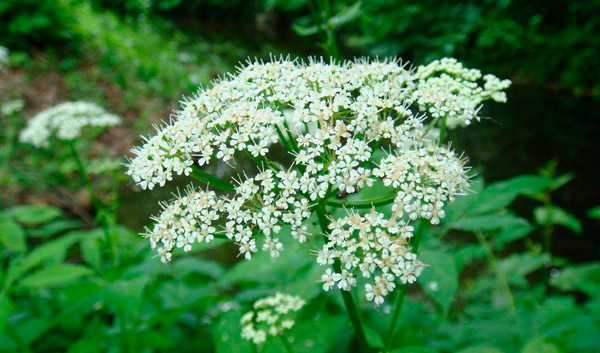
Method of application and dosage. For medicinal purposes, mainly the seeds of goutweed are used, although the herb can also be used in collections.
Here is a recipe for external use of goutweed seeds. In order to ease breathing in case of bronchial obstruction and relieve chest pain in case of bronchitis and bronchial asthma, it is recommended to carry out therapeutic warming. The seeds are fried in a frying pan, cooled slightly and placed in a linen bag. The bag in turn is placed on the patient's chest.
Goutweed seeds are also used as raw material for inhalation solution.
Contraindications for use. It should be said that even completely edible plants may have contraindications. For example, taking goutweed internally (and this is exactly how it is used in herbal mixtures) is not recommended for hypersensitivity to the plant, severe liver disease, increased acidity of gastric juice, or a high risk of bleeding.
Side effects. Ground elder can cause allergic reactions when taken orally, headaches and nausea are possible if the herb is abused. Ground elder is a plant anticoagulant that reduces blood viscosity.
The plant can cause photosensitivity, so active sun should be avoided during treatment with it.
The time for harvesting goutweed depends on the purpose for which it will be used. Leaves harvested in April-May are good for food, but those collected in June-July before the plant blooms can be used to make medicinal potions. Seeds are harvested when the plant has already bloomed.
Goutweed is a plant that cannot be washed before drying, so you need to take only clean leaves, washed by rain or water during watering, but dry. Dry any above-ground parts in the open air in the shade, and finish drying in a dryer or oven, without raising the temperature above 30 degrees.
Store seeds and leaves of goutweed in a sealed glass jar for no more than 1 year.
Horehound (horsemint)
It is considered one of the best medicinal plants for colds and chronic bronchitis. It is in this field that it has gained great popularity. Although many know the plant as a good honey plant and a spicy seasoning for meat dishes.
Marjoram is considered one of the natural antibiotics and has an expectorant effect that is useful for bronchitis.
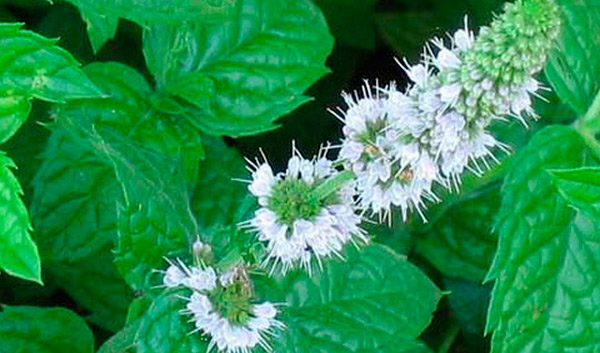
Method of application and dosage. To treat cough during bronchitis, make an infusion or tea from horse mint.
To prepare the infusion, take 1 tbsp. (5 g) of dry crushed grass per 1 cup of boiling water, let the mixture steep for ten minutes, strain and drink as a healthy drink throughout the day, but no more than 4 glasses per day.
You can also prepare a tasty and healthy mixture that helps with unproductive cough. In this case, take 10 grams of the herb per 0.25 liters of water, boil the mixture for half an hour, strain and add 1/3 cup of sugar. Drink the mixture several times a day, 2-3 tablespoons.
And another recipe for treating bronchitis and pneumonia: take 100 g of dry grass per 700 ml of water, boil the mixture until the volume of liquid is half a liter. Cool the decoction and mix it with 2 dessert spoons of honey. A single dose of the medicine is 1/3 cup. Frequency of administration is 4-5 times a day.
Contraindications for use. The plant has virtually no contraindications and side effects, so it can be safely used to treat children, pregnant women, and the elderly.
The plant can be harvested during its flowering period, i.e. throughout the summer, cutting shoots no longer than 35 cm. The plant should be dried in the shade in the open air. It can be hung in bunches on a rope or dried in a dryer with a temperature of up to 40 degrees. The dried raw material is crushed and stored in a glass container, where it will retain its properties for 2 years.
 [ 1 ]
[ 1 ]
Attention!
To simplify the perception of information, this instruction for use of the drug "Expectorant herbs for bronchitis" translated and presented in a special form on the basis of the official instructions for medical use of the drug. Before use read the annotation that came directly to medicines.
Description provided for informational purposes and is not a guide to self-healing. The need for this drug, the purpose of the treatment regimen, methods and dose of the drug is determined solely by the attending physician. Self-medication is dangerous for your health.

